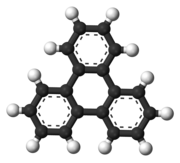This is the current revision of this page, as edited by InternetArchiveBot (talk | contribs) at 01:37, 9 March 2024 (Rescuing 1 sources and tagging 0 as dead.) #IABot (v2.0.9.5) (Maxim Masiutin - 17855). The present address (URL) is a permanent link to this version.
Revision as of 01:37, 9 March 2024 by InternetArchiveBot (talk | contribs) (Rescuing 1 sources and tagging 0 as dead.) #IABot (v2.0.9.5) (Maxim Masiutin - 17855)(diff) ← Previous revision | Latest revision (diff) | Newer revision → (diff)
| |

| |

| |
| Names | |
|---|---|
| Preferred IUPAC name Triphenylene | |
| Other names
Benzophenanthrene 9,10-Benzophenanthrene 1,2,3,4-Dibenzonaphthalene Isochrysene | |
| Identifiers | |
| CAS Number | |
| 3D model (JSmol) | |
| ChEBI | |
| ChEMBL | |
| ChemSpider | |
| ECHA InfoCard | 100.005.385 |
| EC Number |
|
| KEGG | |
| MeSH | C009590 |
| PubChem CID | |
| UNII | |
| CompTox Dashboard (EPA) | |
InChI
| |
SMILES
| |
| Properties | |
| Chemical formula | C18H12 |
| Molar mass | 228.294 g·mol |
| Appearance | white |
| Density | 1.308 g/cm |
| Melting point | 198 °C; 388 °F; 471 K |
| Boiling point | 438 °C; 820 °F; 711 K |
| Magnetic susceptibility (χ) | -156.6·10 cm/mol |
| Except where otherwise noted, data are given for materials in their standard state (at 25 °C , 100 kPa).
| |
Triphenylene is an organic compound with the formula (C6H4)3. A flat polycyclic aromatic hydrocarbon (PAH), it consists of four fused benzene rings. Triphenylene has delocalized 18-π-electron systems based on a planar structure, corresponding to the symmetry group D3h. It is a white or colorless solid.
Preparation
Triphenylene can be isolated from coal tar. It can also be synthesized in various ways. One method is trimerization of benzyne. Another method involves trapping benzyne with a biphenyl derivative.
Properties
Triphenylene is more resonance stable than its isomers chrysene, benzanthracene, benzophenanthrene, and tetracene. For this reason triphenylene resists hydrogenation.
As a disc-shaped, planar molecule, triphenylene has attracted attention as the core of discotic mesogen in liquid crystalline materials.
References
- International Union of Pure and Applied Chemistry (2014). Nomenclature of Organic Chemistry: IUPAC Recommendations and Preferred Names 2013. The Royal Society of Chemistry. p. 209. doi:10.1039/9781849733069. ISBN 978-0-85404-182-4.
- Ahmed, F. R.; Trotter, J. (1963). "The crystal structure of triphenylene". Acta Crystallographica. 16 (6): 503–508. Bibcode:1963AcCry..16..503A. doi:10.1107/S0365110X63001365.
- Heaney, H.; Millar, I. T. (1960). "Triphenylene". Organic Syntheses. 40: 105. doi:10.15227/orgsyn.040.0105.
- Katie A. Spence, Milauni M. Mehta, Neil K. Garg (2022). "Synthesis of Triphenylene via the Palladium–Catalyzed Annulation of Benzyne". Organic Syntheses. 99: 174–189. doi:10.15227/orgsyn.099.0174. S2CID 250383238.
{{cite journal}}: CS1 maint: multiple names: authors list (link) - Kofman, V.; Sarre, P.J.; Hibbins, R.E.; ten Kate, I.L.; Linnartz, H. (2017). "Laboratory spectroscopy and astronomical significance of the fully-benzenoid PAH triphenylene and its cation". Molecular Astrophysics. 7: 19–26. Bibcode:2017MolAs...7...19K. doi:10.1016/j.molap.2017.04.002. hdl:1887/58655. S2CID 67834616.
- Janietz, Dietmar (2001), "Liquid Crystals at Interfaces", Handbook of Surfaces and Interfaces of Materials, Elsevier, pp. 436–437, doi:10.1016/b978-012513910-6/50014-1, ISBN 978-0-12-513910-6, retrieved 2020-08-23
External links
- Polycyclic Aromatic Hydrocarbon Structure Index Archived 2008-02-15 at the Wayback Machine
| Polycyclic aromatic hydrocarbons | |
|---|---|
| 2 rings | |
| 3 rings | |
| 4 rings | |
| 5 rings | |
| 6 rings | |
| 7+ rings | |
| General classes | |